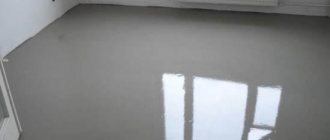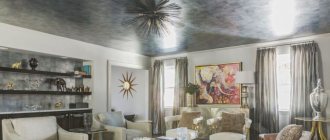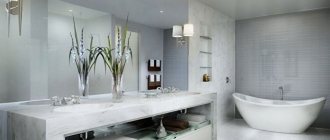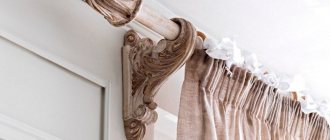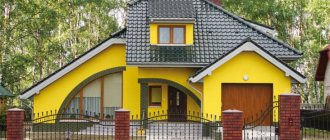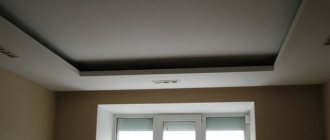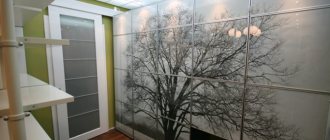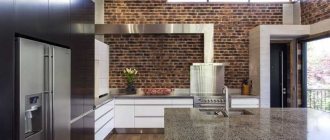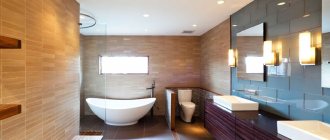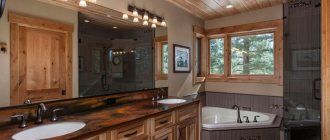Advantages of suspended ceilings
- In the photo of a suspended ceiling in the bathroom you can see how perfectly smooth the surface of such a ceiling is
- Under the suspended ceiling you can hide all communications and wiring, as well as hide water risers
- The suspended ceiling is easy to install and does not require much effort
It is worth choosing this ceiling option in cases where the base ceiling has defects or the ceiling is too complex. With its help you can adjust the height in the bathroom and significantly improve its appearance.
A suspended ceiling provides additional noise insulation and thermal insulation, which is also considered one of the most important advantages of this type of finishing.
Sheathing with plasterboard
First you need to cut the sheathing parts of the required size from plasterboard sheets. To cut the sheet, you need to make a shallow cut with a cutter along a ruler, cutting through only the top cardboard layer. Then bend the sheet, breaking it along the cut line and cut through the bottom cardboard layer. It is better to immediately clean the cut area using a plane. Holes for spotlights are made using a drill and a crown of the required size.
The plasterboard is attached to the frame with self-tapping screws 25 mm long. They must be screwed in with a screwdriver so that the caps remain on the surface and do not break through the cardboard. Having completed the complete covering, it is necessary to perform additional surface finishing. Why seal the seams between the sheets and all the screw heads with putty. After it is completely dry, it is sanded so that the base becomes perfectly smooth. Coating the surface with an acrylic primer allows you to create additional protection from moisture. To paint the ceiling in the bathroom, use interior paint. It holds up well in high humidity conditions.
Types of suspended ceilings
- Plasterboard ceilings.
- Prefabricated structures from elements.
- Stretch ceiling.
The mounting structures depend on the specific type of ceiling. This can be a rack structure, as well as linings, cassettes, square or rectangular panels.
The correct installation of a suspended ceiling in a bathroom depends on the design, but as a rule, installation does not require any special skills.
Recommendations for a small bathroom
For tight spaces, choose light, cool shades and a smooth reflective texture. For the ceiling, a glossy stretch fabric in white, soft blue or pale gray is suitable. Chrome slats or mirror plates will also look good.
Important! If the ceilings in the bathroom are higher than 3 meters, there is no need to increase them further. The room will look like a well. In this case, choose a matte surface and rich color.
If the room is too narrow, transverse stripes will expand the area. They are made in several ways:
- lay slats or plastic lining along a short wall;
- draw stripes on the painted surface (it is convenient to mark the boundaries with paper tape);
- they make photo printing on a stretch ceiling or solder films of different colors;
- if the height allows, beams are attached; for decorative purposes, false beams made of polyurethane are often used; they are easy to install and allow you to install additional lighting.
The ceiling plinth also affects the perception of volume. If you need to expand the room, it is selected in the same color as the walls, and to increase the height - with the ceiling.
Choosing a suspended ceiling
When choosing a ceiling, you need to rely not only on the appearance of the finish, but also on the following factors.
- Large ceiling structures visually reduce the space;
- Warm and bright shades make the ceiling visually closer, while cool colors move it away;
- You should be careful when choosing a mirrored suspended ceiling for the bathroom. Instead of making the room appear larger, it adds saturation and can become irritating very quickly;
- To make the design of the suspended ceiling visually lighter, you need to choose contrasting tiles or expressive decor for the walls. Expressive walls will attract all attention to themselves, relegating the ceiling to the background;
Coloring
Gone are the days when bathrooms were painted with blue and green oil paints. Today's paint and varnish manufacturer presents a huge range of samples designed for wet rooms.
The dullness of a monochromatic coating can be easily diluted by combining several colors or applying a pattern. Flock coating, textured and decorative paints that imitate various surfaces significantly expand the choice of design solutions. And it is quite possible to get an original ceiling covering without significant financial costs.
Maintenance will not take much time and effort; just wipe with a damp sponge, and darkened areas can be renewed by applying a new coat of paint.
- Ceiling with wooden beams
- Types of suspended ceilings - which one to choose?
Options for finishing the ceiling in an apartment: advantages and disadvantages
When choosing lighting, it will not be possible to install spotlights; there is simply no room for recessed spotlights. You will have to make a choice among overhead lighting fixtures.
Painting the ceiling requires preliminary leveling of the rough base. In cases where there are significant differences between the slabs, it will not be possible to get by with putty alone; plastering or installation of a suspended structure will be necessary.
By choosing high-quality paint and carefully preparing the base, you can forget about repeated repairs for ten years.
Suspended plasterboard ceiling
The most popular type of suspended ceilings is still plasterboard ceilings. Their features include:
- Affordable material cost
- Ability to create designs of different shapes and sizes
- Treatment with a moisture-protective compound to extend service life
- Perfectly flat surface
- Environmental friendliness and maintaining a normal microclimate
- Easy installation and variety of appearance
Work on installing a plasterboard ceiling includes installation, putty, primer and painting. Heavy structures cannot be attached to drywall; this is the only nuance that is worth considering.
Do-it-yourself suspended ceiling in the bathroom: installation of plasterboard
Step-by-step instructions for installing suspended ceilings in the bathroom will help you do the job yourself.
Stage 1. Selection of materials and tools.
You need to start by choosing the most suitable ceiling covering. When choosing materials for a suspended ceiling in a bathroom, give preference to moisture-resistant options. Suspended ceilings made of moisture-resistant plasterboard or PVC slatted ceilings are not afraid of temperature changes or high humidity. They do not deform and retain their original appearance for a long time.
When working with drywall, keep in mind that the edges are a layer of gypsum that must be protected during installation.
If you decide to install suspended ceilings in the bathroom yourself, check that you have the following tools:
- bubble level;
- measuring tools (tape measure, centimeter);
- hand drill or hammer drill;
- screwdriver or screwdriver;
- stationery knife and hacksaw;
- pencil or marker for marks.
In addition to the ceiling covering, the following materials are required for mounting the frame:
- ceiling profile;
- suspension;
- guide profile;
- connectors;
- dowels;
- self-tapping screws;
- starting strip (for slatted ceiling).
The amount of material required is calculated in advance, based on the area of the bathroom ceiling.
Stage 2. Installation of plasterboard sheet.
Installation of plasterboard suspended ceilings in the bathroom begins with fastening the profile frame. To perform this work correctly, it is necessary to carefully calculate the zero level and attach a guide profile to it using dowels located at a distance of 50 cm from each other.
A ceiling profile reinforced with hangers is attached to the guide profile. Cross lintels will add even greater strength to the structure.
A sheet of the required size is cut out of plasterboard and attached to the reinforced profile with self-tapping screws. If you plan to place spotlights, then the necessary holes are made in advance, and not after attaching the sheet to the frame. All parts, including holes, are made with a construction jigsaw. This makes them more accurate and accurate.
Upon completion of installation, the joints and seams are sealed with reinforcing tape or puttied. After this, you can begin any other repair work and decorate the ceiling surface.
Slatted suspended ceiling
Knowing how to make a suspended ceiling in a bathroom from slats, you can create a strong and durable structure. To make this type of ceiling, aluminum is used, which is covered with tinting.
A closed slatted ceiling is a sheet of solid aluminum slats with no gaps between them. This ceiling can look very beautiful if you choose the right shade of paint.
The open type of slatted ceiling is the installation of slats, taking into account the design and gaps, with the help of which you can make a shaped covering. This type of ceiling is most often used for bathrooms, since aluminum is resistant to fungi and corrosion, and is also not afraid of moisture.
The slats are mounted on lightweight profiles, so the structure is lightweight.
Lighting in a bathroom with a suspended ceiling
The placement of lamps is planned even before the installation of the PVC sheet. According to existing standards, the illumination of a bathroom for a comfortable stay in it should be 200 lux.
Based on this value, the number of ceiling lights is calculated, taking into account the fact that PVC fabric melts at high temperatures and it is allowed to install light bulbs with a power of no more than 40 W.
Important: the bathroom is a high-risk area where flooding is possible, and constant humidity poses a potential threat to electrical appliances. Therefore, it is necessary to choose suspended ceiling lamps marked IP 7 - 8 units, which means the maximum degree of water resistance. They are protected against short circuits and corrosion and have a longer service life.
Lamps can be:
- built-in
- invoices
In the first case, installation is carried out directly in the plane of the tension fabric. To prevent PVC film from melting and deforming from heating, it is recommended to use only LED lamps. Their advantages:
- low thermal conductivity
- efficiency
- uninterrupted operation
- high level of energy saving
- durability (up to 10 years)
The disadvantages include a cold, bluish glow, which not everyone likes.
Overhead lamps are mounted above the ceiling plane. This allows the use of all types of lamps: incandescent, halogen, fluorescent and LED. In addition to this significant advantage , we should also note the ability to change the angle of inclination, which creates a bizarre play of chiaroscuro on the ceiling. The downside of the model is that its design has to be selected very carefully so as not to disturb the style of the interior.
For lighting in a bathroom with a suspended ceiling, you can also use chandeliers, raster lamps or spots.
Stretch ceiling in the bathroom with lighting
There are two options for the location of lamps:
- along the perimeter
- above the tension fabric
To emphasize the contour of the ceiling, an LED strip or durolight cord with different shades is used.
Illumination from inside creates the impression of daylight pouring from the ceiling. This is an excellent solution for bathrooms in both modern and classic styles (see photo ). You can also use LED strip to lay out various patterns that will appear when turned on.
The most beautiful type of illumination from the inside is the so-called “starry sky”. It also uses LEDs, but not strips, but separate devices glued to the base concrete floor.
Stretch ceiling in the bathroom “starry sky” further in the photo :
Suspended ceiling made of PVC plates
PVC boards have a number of advantages that make them a very popular material.
- Excellent moisture resistance;
- Variety of design solutions;
- Long service life;
- PVC boards do not require additional finishing;
- With the help of such a ceiling you can zone the space;
- The slabs are not afraid of any chemicals;
You cannot install a ceiling made of PVC slabs near heating elements, as the plastic can emit harmful substances. A suspended ceiling for a bathroom made from panels is an affordable and convenient option that is always in demand.
Stretch ceiling
This is a very famous type of suspended ceiling that has many advantages. Most often they are made from a special PVC film, and their features include the following points:
- Wide color palette and photo printing capabilities
- Large selection of textures - gloss, matte surface, relief, velvet and so on
- Easy installation
- Resistance to moisture, corrosion, rotting
The film is treated with special means that prevent the formation of condensation.
The disadvantages of such a ceiling include physical harm, it can be easily pierced with a sharp object and a limited choice of lighting; you need to choose lamps that are not subject to strong heat.
Wooden suspended ceiling
This ceiling has a very respectable appearance and fits perfectly into an eco-style interior. It is environmentally friendly, has excellent thermal insulation properties, absorbs sound well and is available in a wide variety of shades and textures.
The panels are made from wood chips, which are covered with veneer. Despite its advantages, suspended ceilings made of wood have a high cost, as well as low fire safety.
Cost of suspended ceilings
When choosing suspended ceilings, it is important to know the prices for suspended ceilings in the bathroom, which are presented in a variety of price categories.
- The most expensive options are suspended and wooden ceilings, but the advantages of a suspended ceiling completely determine its cost.
- The most affordable are plasterboard, plastic and slatted ceilings, which offer a reasonable price and an excellent set of positive qualities.
When choosing a suspended ceiling, you need to focus not only on cost, but also on the practical properties of the material, on which the durability and functionality of the ceiling depends.
Plastic panels - a practical finishing option
Plastic is a good material for installing a ceiling in a bathroom. Dampness and water will not prevent it from serving for several years without losing its properties. Plastic panels can be called the “golden mean” in terms of quality and price.
- Plastic is considered the most practical option
- You can easily install original lighting in the panels
- The panels look stylish, laconic and modern
- A bathroom ceiling made of plastic panels will last for several years and will not require additional cleaning and maintenance efforts.
plastic panels for ceiling photo
In fact, by choosing this finishing method, you will get a smooth plastic surface, which is laid using special panels. They are fastened “at the joint”, and after the entire installation, a smooth and uniform plane is obtained.
plastic panels for the ceiling in the bathroom photo
Another significant advantage of this material lies in the ease of installation - a business man will be able to independently install plastic panels on the ceiling. But along with this advantage, there is also a disadvantage - if the installation is carried out poorly, it may be visible that the ceiling is “covered” with separate pieces of plastic.
wood-look plastic panels for the ceiling photo
